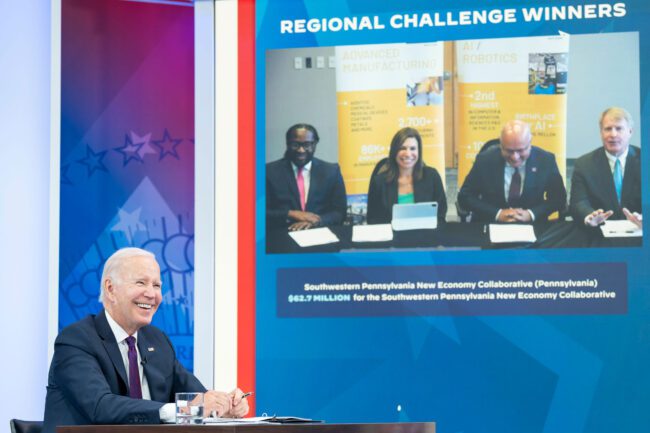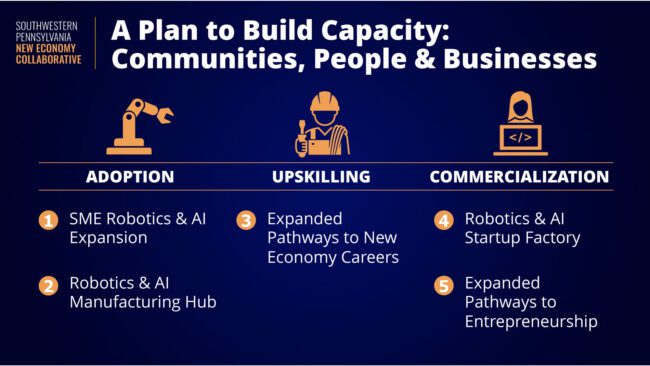on Sep 29, 2022
How to win a $63 million federal grant as a first-time applicant

Written by Kate Wittels and Giacomo Bagarella
The Infrastructure Investment and Jobs and Inflation Reduction Acts present communities with once-in-a-generation opportunities to pursue federal funding. Historically, communities with more resources or experience navigating the complexities of the federal funding landscape have had greater success. Politics also plays a major role in decision-making. Both facts, along with a lack of equity-driven thinking in the design of these programs has reinforced long-standing inequities.
We have shared federal funding success stories from HR&A’s clients in previous features, but working with the Allegheny Conference on Community Development, a non-profit economic development organization active in southwestern Pennsylvania, was perhaps the single most exciting instance of disrupting this status quo. In early September, the Economic Development Administration (EDA) announced that the Allegheny Conference and southwestern Pennsylvania were one of only 21 Build Back Better Regional Challenge (BBBRC) awardees and one of only five that received over $60 million.
Our work supporting clients pursuing federal funding opportunities suggests the critical importance of having tools and processes to simplify the complexity. Even trying to identify programs for which you are eligible can deter organizations that haven’t engaged in the process before; our recently launched Infrastructure Funding Navigator helps with that particular challenge. In Allegheny Conference’s case, a dynamic impact model and a robust application management strategy were keys to success winning the federal funding game.
Although the Allegheny Conference had the support of the community and was well-positioned to lead the effort, it had never submitted a federal grant application before. It brought on HR&A to support the effort, because as Vera Krekanova, Chief Strategy & Research Officer put it, “HR&A had the tools, lived experience, and internal organization to understand how to navigate the federal funding process.”
At the conclusion of the effort, Allegheny Conference leaders, including the organization’s CEO Stefani Pashman, sat down with us to reflect on what drove success.
Identify the problem and envision a unifying solution that will have lasting impacts for all.
The 11-county southwestern Pennsylvania region is home to 2.7 million people, one in five Pennsylvanians. Like 12 other former coal and industrial communities that received BBBRC grants, southwestern Pennsylvania has struggled to recover from the decline of those industries. With major employment loss came significant population loss — particularly in rural counties.
To address these issues, Allegheny Conference developed a proposal to rebuild a knowledge-driven economy that will transform assets into a system to benefit everyone within the region. In the view of Conference leadership, this twin focus on systems and equity helped them secure one of the largest BBBRC grants and funding for all five of their proposed projects.
Within the region, energy, healthcare, and advanced manufacturing are recognized strengths. HR&A worked with the Allegheny Conference to identify a unifying economic driver that would build on these strengths, improve opportunities for a diversity of communities, and leverage world-class research and development at Carnegie Mellon University (CMU) and other local institutions. As a result of a robust community engagement process, Allegheny Conference leadership identified an opportunity to “supercharge the … globally recognized robotics and autonomy cluster and ensure that its economic benefits equitably reach rural and coal-impacted communities,” thereby improving the lives of nearly 15,000 workers.
Erect a big tent and invite your community in, building a vision together without diluting its impact.
The Allegheny Conference started by leveraging its existing connections to bring more than 90 public, private, philanthropic, labor, education, and economic development stakeholders together for regular conversations. The application’s focus on robotics and autonomous mobility emerged from these conversations.
We began with a discussion of how establishment of a unifying theme that could demonstrably benefit every coalition member would strengthen the application. In these early conversations, it became clear that everyone — from farmers to pharmacists — could benefit from the adoption of robotics. While funding for research and development was critical to make sure ideas emerging from educational partners turned into companies, it was equally important to ensure that regional businesses were ready to be customers of these robotic technologies and that the local workforce was able to use robotics and had the skills to help scale the robotic companies themselves. The overarching vision that emerged was of a focus on the entire supply chain rather than one aspect, which would have narrowed the impact to a single party, geographic community, or stakeholder type.

Create an application management plan.
We needed a system for efficient decision-making. HR&A recommended core principles for application management that the Allegheny Conference relied on throughout the process:
- Inform everyone
- Bring together local experts
- Be open to feedback
- Make sure you have people who call the shots
- Inform everyone again
Allegheny Conference and HR&A supported the stakeholder coalition, developing templates for members to develop BBBRC-compliant programs, which would later be synthesized and summarized in the application. Among the tools we developed for coalition members preparing these program descriptions was a cost-benefit model to evaluate relative impact if money were reduced or added to a specific project. Another tool developed for coalition members was a prompt to facilitate consideration of the rationale for each project and the role it would play in equitable, systemic change.
The Allegheny Conference also assigned tasks and responsibilities, pushing as much content drafting as possible to local experts, while retaining management of the overall process, narrative, and quality control.
With consistent communication and adherence to the application management plan, the Allegheny Conference built trust across the coalition. This proved critical when amendments to the proposal were required by EDA in the final stages of the award process.
Translate federal priorities and principles so they make sense to your local stakeholders.
The Allegheny Conference recognized how important it was for the entire coalition — not just the applicant — to speak EDA’s language. EDA’s articulated priorities differed somewhat from past federal funding opportunities, requiring proposals that offered “transformational investments to develop and strengthen regional industry clusters…while embracing equitable economic growth, creating good-paying jobs, and enhancing U.S. global competitiveness.”
The Allegheny Conference and HR&A identified five projects that could transform the region’s robotics, automation, and manufacturing economy and aligned with EDA priorities, including closing “not just racial and ethnic, but also geographic” equity gaps, and then wove them together, both in the imaginations of project sponsors and in the application narrative, advancing a theory of change that relied on the five projects functioning as an integrated regional system. As Allegheny Conference CEO Stefani Pashman said, this win “will bring renewed vitality to our 11-county region and enhance opportunities for a wide band of people, businesses and places in ways we have not seen before. These projects are designed to open doors to anyone who wants to participate in the region’s thriving robotics cluster. This includes expanded opportunities for women and people of color, as well as provide geographic equity throughout the region.”
Presentation of the projects as an integrated system enabled both the coalition and EDA to see the importance of funding the entire package and the tradeoffs if one or more projects were not funded. EDA ultimately funded all five projects — distinguishing the submission from many others, where EDA funded only one or two. The Allegheny Conference proved that with the right tools and a well-considered framework for impact, even organizations that have never played before can win the federal funding game.
Images courtesy of Allegheny Conference.